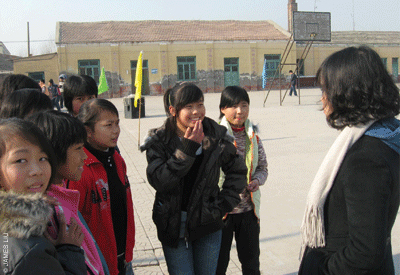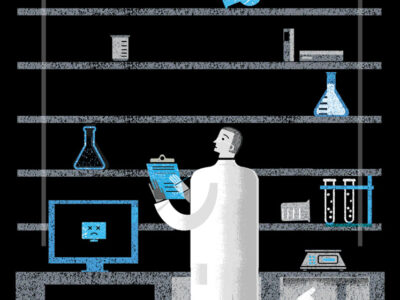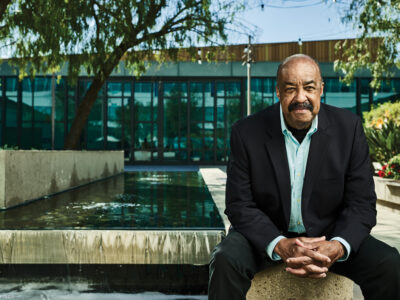
As an undergraduate researching her senior thesis, Jennifer Chen C’08 W’08 traveled to a remote village in a part of northern China called Ningxia. It was way out in the sticks. She arrived in the midst of a downpour. The village headman and an education official ferried her beneath an umbrella to an office with no computer, one phone, and a very small desk. There they talked about challenges faced by local grade-school students.
Some of these made the old uphill-both-ways-in-the-snow routine look like a stroll on red carpet. The nearest middle school, for instance, was so far away that only children who passed an aptitude test and had enough money to pay for room and board there could attend it.
A visit to a local family’s house showed the unlikeliness of such a financial surplus. “There was one small desk used for eating and studying,” Chen recalls of the single-room dwelling, “and nowhere to sit but their bed.” The bed also functioned as a primitive furnace. “It’s actually called a kang,” says Chen, who was born in China and returns frequently. “You have to heat underneath the bed with firewood to keep warm in the winter. I remember reading about this sort of structure, but I’d never really seen one.”
It was the kind of experience that drove her and classmate Joyce Meng C’08 W’08 crazy. “Every time we talked, we felt really powerless,” Chen says. “We were doing all this academic reading and writing, and yet not doing anything to help these children out.”
That’s not strictly true. Meng won a Rhodes Scholarship with a résumé that included co-founding a small bank and business incubator for Nigerian street youth [“Gazetteer,” Jan|Feb 2008], and Chen ended up raising a substantial donation for those villagers.
But their problem was the same one that afflicts most college kids: they were richer in empathy than in dollars. Writing a small check to a big charity seemed inconsequential—especially since donors typically have little idea where their money actually goes, or how much of it gets there. Yet doing nothing was worse. After all, both knew firsthand just how far a small donation could go in a place like Ningxia.
As graduation neared, they and several other seniors hit on a potential solution to their quandary. They took their inspiration from Kiva, the Web-based, person-to-person microfinance organization that has facilitated over 90,000 small loans to developing-world entrepreneurs. As Meng recalls, “We thought, Why can’t we bring that same degree of transparency, immediacy, and also that community around giving to education?”
So in September 2008, they launched Givology.org, a website designed to connect small-scale donors to small-scale education philanthropies. “There are so many truly amazing organizations around the world doing grassroots education initiatives,” says Meng. “But they either don’t have a very attractive Internet strategy or they’re very small and fragmented, so you never hear about them. We felt like we could do two things: first, leverage the notion of an online-giving marketplace and make philanthropy much more democratic [by means of] small-denomination grants; and second, to help provide all these innovative grassroots education organizations a new channel for fundraising.”
The case of Longfeng Ran, a 17-year-old girl from Sichuan, illustrates one way Givology works. When her father sustained a leg injury that impaired his ability to generate farm income, the impoverished family could no longer support her school tuition. A nonprofit educational charity called the Peach Foundation, working with local teachers, determined that Ran had demonstrated “outstanding conduct and scholastic achievements” that merited a $250 scholarship. The amount, which nearly equaled the family’s annual income, would go primarily toward tuition and school supplies. That’s where Givology came in. It posted Ran’s picture along with a short autobiography in English translation on its website. Nine donors read her story and contributed. When the scholarship was fully funded, the money was disbursed. Additionally, the website provides a way for donors and beneficiaries to communicate with one another.
Givology also operates at the project level. “One that we really like is Light For Learning” in Uganda, says Meng. In partnership with AHEAD Energy, a nonprofit based at the University of Rochester, Givology hopes to outfit a rural primary school with a reliable energy source it currently lacks. “We are funding the purchase of solar panels and other forms of renewable energy generation for the school,” Meng explains. “And the amount it would actually provide constitutes a little bit of a surplus, so the school would be able to sell a little of this energy to the village.” As the Gazette went to press, $222 had been pledged toward the $500 project.
Carl Mackey EE’08, Givology’s chief technical officer, says that what attracted him to the organization—which is run entirely by volunteers—was the specificity and transparency it offers. “I don’t have a lot of faith in charities that you donate to generically,” he says. “Givology is supposed to be different … the focus is on donations aimed at particular students or projects. And with the exception of transaction fees from credit card companies or banks, the money allocated goes directly to helping the students and projects, which is something I can’t necessarily be sure of with other charities.”
The flip side of the all-volunteer model is that many members of the team now work in the private sector. They hope that will enable them to build fundraising networks in slightly different terrain than if they moved exclusively in nonprofit circles. For example, vice president Xiang Li C’08 W’08, who works for Microsoft, has enrolled Givology in a company program that matches volunteer hours with some funding.
Givology departs from the traditional model in another way. “If something goes wrong, we tell everyone, and we refund money directly back to the donor’s wallet,” Meng says. “We’ve already done that once. There was a death in a student’s family, and the student ended up dropping out of school and working in the fields. We refunded the money back to the donor so that they could either reallocate it or take the money away … We really do care about tracking where the money goes.”
So far, Givology’s impact has been modest. About 250 donations have channeled a little more than $7,000 to 34 students and 12 projects. Its founders take pride in their avoidance of administrative costs, however, and are trying to grow by means of local chapters at colleges and universities. “They can help put in some of the work in terms of marketing, fundraising, and identifying new partners,” says Meng, who is currently serving as CEO. At the moment, there are chapters at Penn, Columbia, and Beijing University.
Givology’s model also provides a productive outlet for the idealism some students don’t want to lose as they move on from college. That’s part of the appeal for Chen, who volunteers about 10 hours a week as its president in addition to working full-time for a private equity firm.
“You know, doing private equity is not exactly the most humanitarian business that one can get involved in,” she says. “And sometimes I think that while I’m developing other skill sets here, I’m also sort of losing a side of me that I don’t want to lose—that connection with the underprivileged.
“Givology sort of reminds me daily of who I really am, and what I believe in,” she adds. “My peers, and people who are older than me, they kind of enter this world of finance and change. And so Givology was—and I’m being completely truthful—somewhat selfish for me, in that before I even entered my job, I wanted to make sure I had Givology so that I wouldn’t change.”
—T.P.




